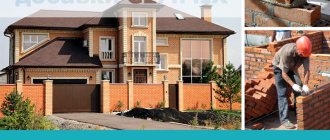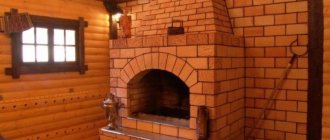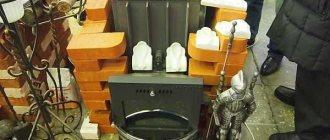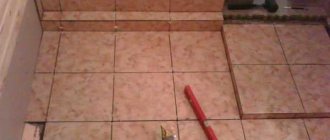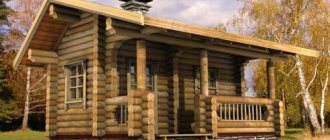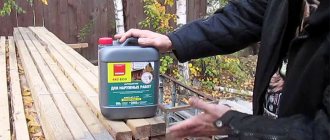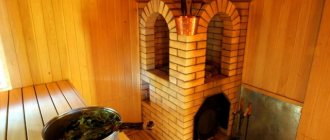When planning to build a fireplace or brick stove with your own hands, you need to choose the right materials. And we are talking not only about bricks, but also about the mixture for laying stoves. The correct choice of materials affects the properties of the finished product.
Mixture for masonry stoves
Modern craftsmen use different mixtures for laying stoves; to lay bricks with your own hands, you can choose a composition based on different bases. Compositions used:
- Cement;
- Mixed, consisting of several binding elements;
- Gypsum mixtures;
- Calcareous.
For masonry and cladding, as a rule, binders of mineral origin are used:
- Clay;
- Lime;
- Gypsum;
- Cement.
Fireproof mixtures for stoves and fireplaces are divided into several types:
- Clay , used for laying the main structural elements;
- Cement , used in the manufacture of foundations in wet soil. Used in the manufacture of external pipes. Used for preparing mixtures when installing chimneys above roof level.
Types of mixtures for laying fireplaces and stoves
Heat-resistant mortar is used for laying red brick.
Fireplace and stove structures are built from natural stone or refractory brick. To make the structure monolithic, various compositions are used. They are suitable for external masonry, firebox and chimney construction, pouring foundations, cladding and creating heat-resistant elements.
Based on the type of resistance to high temperature and fire, you can select a masonry stove mixture:
- heat-resistant – maintains the integrity and load-bearing strength of the structure at high temperatures;
- heat-resistant - protects the structural integrity of the masonry when exposed to fire and mechanical force;
- fireproof - the property of viscous products that are resistant to fire and the effects of combustion products.
The composition and proportions depend on the type of stove element.
Heat-resistant mixtures
Examples of heat-resistant dry mixtures for masonry stoves
The material is able to withstand heat, maintain the load-bearing capacity of the structure and not deform from high-temperature exposure. The standard mixture for pouring a monolithic firebox or erecting a frame is made on the basis of:
- 1 part of Portland cement grade M400-M600;
- 2 parts of ceramic crushed stone M150;
- 2 parts of fine quartz sand with fractions of 1 mm;
- 3/10 parts fireclay sand;
- water in the amount of 4 liters per 10 kg of mixture.
Purchased and self-prepared solutions are mixed in a concrete mixer - all ingredients are added gradually.
Finished materials are cleaned of organic matter, which eliminates the release of carbon monoxide during furnace operation.
Fireclay compositions
Crushed fireclay clay in a dry mixture for laying out the firebox.
A mixture based on refractory clay and quartz sand crushed to fine grain is characterized by:
- fire resistance depending on the manufacturer - from 1550 to 1850 degrees;
- average size of fractions from 2 mm
- moisture absorption - 2-10% for high-burnt fireclay, approximately 25% for low-burnt fireclay.
The fireclay product is supplied in 20 kg bags, which is enough for laying 20-30 bricks. The construction of the chimney and firebox is carried out from a clay-fireclay mixture in proportions 1:1. You will need ¼ of water.
On a note! Refractory clay is used for facing work, but only 4 weeks after the first fireplace fire.
Dry Potting Powder
Cement aluminate for preparing pouring mortar
Fire-resistant material based on cement aluminate and fireclay clay with fractions of 0.5 mm is used for pouring and repairing the internal parts of stoves, grills and fireplaces. Available in the form of a gray powder, scattered in 25 kg bags. Has the following properties:
- permissible minimum filling temperature - +5 degrees;
- hardening time - 1 hour;
- the yield of the finished mass is from 11 to 12 liters from a 25 kg bag;
- temperature resistance up to +1300 degrees.
The solution is mixed in a concrete mixer. You need to gradually add from 2.5 to 3.5 liters of water per bag. Large parts of the stove are poured with a layer of 50 mm, the roof - with a layer of 100 mm.
The refractory mass cannot be reinforced - its thermal expansion is less than that of metal.
Cement-sand mortar
The neck of the chimney, the head and the foundation of the furnace are laid out on a cement-sand mortar. Of course, its plasticity and temperature resistance are worse than that of clay, but it holds the entire structure of the stove well in the foundation masonry and does not spread out under the influence of precipitation on the chimney.
It is strictly not recommended to place the furnace body, furnace, and other parts of the structure exposed to high temperatures on cement!
For stove masonry, use cement marked M400–600.
Proportions with sand - 1/6 or 1/3. sand is selected according to the same principle as for clay mortar.
To increase strength, lime is often added. The proportions of cement, lime, sand are 1/1/6 or 1/3/6.
Characteristics of oven mixtures
High-quality mixtures for stoves and fireplaces must have the following characteristics:
- heating limit from 1300 to 1780 degrees - heat-resistant material does not crack when exposed to high temperatures;
- finished density from 1000 to 1800 kg/m3 – allows you to form a durable layer with high thermal conductivity;
- frost resistance - up to 70 freezing and thawing cycles allows for external and internal construction;
- heat resistance, strength and ductility - properties increase the service life of the furnace;
- environmentally friendly - materials without volatile impurities and chemicals do not emit carbon monoxide during the fireplace combustion process;
- flammability class - a heat-resistant product is classified as NG (non-flammable);
- vapor permeability – from 0.09 mg/m*h*Pa – prevents molding of the seam.
A good composition during operation easily adheres to the surface, has a plastic structure and is easy to apply.
Comparison of factory-made and home-made mixtures, pros and cons
The advantages of ready-made formulations include:
- Fine grinding, careful control of the proportions of the main components.
- The presence of specialized (in some cases, secret) additives, including reinforcing fiber, aluminum oxides and sodium silicates.
- Possibility of purchasing both universal and specialized brands.
- Formation of neat seams, coatings, attractive appearance.
The disadvantages are the high price, the risk of purchasing counterfeits or improperly stored mixtures. When purchasing ready-made mixtures for laying stoves, fireplaces, chimneys, be sure to check the condition of the packaging, the presence of a quality certificate and permission to sell the brand. When constructing Russian stoves or structures with a non-standard configuration, the calculated amount of material may not be enough (not least due to ultra-fine grinding), mixtures are purchased in excess, which again leads to unnecessary expenses. After opening the package, dry ready-made formulations quickly lose their beneficial properties.
“Homemade” mixtures are inferior to factory ones in the accuracy of tracking the quality and proportions of components, but are several times cheaper. Self-kneading pays off:
- With a limited work budget.
- If there is a quarry nearby for the extraction of clay or sand, as well as confidence in their quality.
Career - For low and medium requirements for strength and decorativeness of structures.
Budget fireplace
In most cases, self-prepared mixtures are used in the construction of the main body of the stove; for the firebox and cladding it is worth buying factory-made fireproof plasters and masonry varieties.
Advantages and disadvantages
You can quickly prepare a high-quality solution from a purchased mixture.
For laying stoves and fireplaces, a high-temperature mixture is used, which contains clay, sand, lime or cement, and heat-resistant ingredients. To obtain a homogeneous mass, water must be added to the material. Using finished products has several advantages:
- ease of mixing components;
- ready-made recipe that ensures the strength of the composition;
- versatility of use - suitable for cladding, laying external and internal parts;
- attractiveness and evenness of the masonry seam;
- availability of complete instructions with operating and mixing rules;
- ease of application and no risk of seam destruction.
The use of building materials is associated with some difficulties. The mass is mixed only with a mixer or in a concrete mixer, it hardens quickly, so it is prepared in portions.
Fireproof putties
In addition to traditional refractory mortars, putty materials are also used in finishing work. They are used for lining heated surfaces. Almost all materials for such work have a similar composition, only the proportions of the components differ. The basis everywhere is clay and lime.
Most often, fireproof putties are used to finish the stove for further finishing. The mass has the following advantages:
- Safety. The composition of the substance is environmentally friendly. When heated, the putty does not release components harmful to humans.
- Fire resistance. Even with strong heating, the formation of cracks on the surface of the putty layer is unlikely.
- The service life of the coating (if properly applied) is more than 40 years.
- High degree of adhesion with other building materials and coatings.
When finishing the stove, it is important to follow the correct sequence of application of materials. Otherwise, the finish of the product may crack.
Selection of mixtures for structural elements of the furnace
Fireproof fireclay mortar is necessary for laying the firebox and elements close to an open fire.
To select masonry materials, it is necessary to take into account that the stove consists of several elements:
- The foundation cushion is a monolithic element built separately from the foundation of the house.
- The base of the furnace is not subject to temperature stress, therefore it is built from solid red brick. Lime or lime-cement mortar is suitable for masonry.
- Fire blind area - represented by a sheet of asbestos or mineral cardboard, on which there is an iron sheet and felt impregnated with clay.
- The furnace mass - due to the increased impact of hot flue gas on the structure, is built from ceramic bricks with clay mortar.
- The firebox gets very hot, so it looks like a monolith on a fire-resistant clay-chamotte mortar.
- The beginning of the chimney is heated to +400 degrees, which requires laying on a mixture with a clay base.
- Otter, or fluff, is an element connecting the chimney and the ceiling. Temperature and aggressive effects on it are minimal, so a lime composition is suitable for standard bricks.
- Fireproof cutting is a heat-insulating metal box that does not require a solution.
- The chimney and fluff are exposed to wind and chemicals. Installed using red solution.
The correct choice of solution will save 10-12% of funds on the purchase of consumables.
Lime mixture
Lime mixture is used for laying outdoor stoves, as it does not absorb water.
The fireproof mixture for stoves consists of sand, lime paste (1 part quicklime + 3 parts water). To prepare it yourself, you will need to sift the sand, mix it with the dough in a ratio of 1:3 and add water until the sour cream becomes thick.
The heat resistance of the product is from 450 to 500 degrees, but it is non-hygroscopic. The product is used outdoors to treat the part of the pipe protruding above the roofing. Due to toxicity and duration of contraction, lime materials are best used outdoors.
To increase strength, cement can be added to the lime mortar, and gypsum can be added to speed up adhesion.
Cement mixture
Cement-based mortar is used in foundation construction.
It is divided into three types:
- Cement - preparation requires water, cement and sand. Greater strength and low gas density allow the compositions to be used for foundation construction.
- Cement-clay - durable mortars, with the help of which the thermal part of the fireplace and the beginning of the chimney are laid out.
- Cement-lime mixtures are strong, but have a low gas density. Suitable for the construction of fireplaces, foundations, chimneys.
To make it yourself, you will need to mix 1 portion of cement with 1-3 portions of additives and 6-15 portions of sand.
The heat resistance of the cement mass can be enhanced using Portland cement and broken bricks.
Clay mixture
The material is suitable for the construction of a furnace array. The ideal mixture does not crumble, has a homogeneous structure without lumps and the consistency of sour cream. Factory materials are made on the basis of:
- white clay - increases the fire resistance of the mass, suitable for the construction of wood-burning stoves with heating of the firebox up to 1000 degrees;
- fireclay clay is a universal product that ensures the strength of the stove structure at any temperature.
To increase strength, you can add to the solution:
- table salt or sodium chloride - 100-150 g are needed for 1 bucket;
- Portland cement - for 1 bucket you will need from 500 g to 1 kg of product.
The consumption of clay mixture per 100 bricks is 25 liters.
Masonry mortars for individual furnace structures
General requirements for the solution are:
- heat resistance – ensures the safety and functionality of the oven;
- elasticity is a condition for good crack resistance of furnace walls.
Based on the type of binders, all oven mixtures are divided into:
- cement;
- gypsum;
- limestone;
- mixed (if they contain more than one binder).
Furnace foundation. For its construction, lime or cement-lime mortars are used. If there is excessive moisture in the base under the foundation, cement mortar should be preferred; it is not afraid of moisture.
Chimney. For the part that protrudes above the roof, use lime or lime-gypsum mortar. If it is necessary to speed up the setting of the solution, then gypsum is added to it. If the priority is the strength of the masonry, then cement is added.
Furnace body. You can't do without clay here. The solution consists of clay, sand and water. The quality of the solution is greatly influenced by the fat content of the clay.
Selecting the proportion and checking the solution
The solution must be tested for fat content using beads.
The amount of ingredients depends on the location and purpose of the stove structure. To build a structure in a house you will need:
- 1 part sand + 1.5 parts clay;
- 3 parts sand + 1 part lime paste;
- 1 part cement + 8-10 parts sand + 2 parts lime paste;
- a heat-resistant mass for a monolithic firebox is prepared on the basis of 1 part of portlad cement M400, 2 parts of broken brick, 0.3 parts of fireclay sand;
- refractory concrete can be made by mixing 20 kg of the finished composition with 8 liters of water.
A brick sauna stove is built on the following mortars:
- cement - 1 part cement + 3 parts sand;
- limestone - sand and lime have a 2:1 ratio;
- lime-cement - you need 2 parts lime, 1 part sand, from 6 to 16 parts cement.
The firebox is laid out using clay-fireclay mass. For plastering, asbestos + lime + sand + gypsum, clay + asbestos + sand or clay + cement + sand + asbestos are used.
For outdoor structures, it is better to use a moisture-resistant composition based on 3 parts sand and 1 part cement.
Mixture testing
The fat content of the solution is determined by the number of cracks when the ball is compressed.
The quality of the lime paste is checked using a wooden lath. During the mixing process, the type of mass is determined:
- there is no material on the plank - thin mortar, corrected by adding lime;
- lumps or film remain on the rail - the product is suitable for the job;
- a thick, dense layer remains on the board - a greasy mass, to which you should add a little sand.
Before using the clay solution, the fat content is tested. You will need to dilute 2 kg of clay with water, mix with a wooden stick and inspect it:
- Clay has stuck to the rail - a greasy substance that is hardened by sand;
- small pieces stuck to the blade - you can start laying;
- There is a film left on the bar - the material is thin, it needs to be corrected with rich clay.
Salt or plasticizers can be added to formulations to improve adhesion.
Features of preparing working solutions
Regardless of the chosen composition of the refractory mixture, the master will need water in any case.
It should not contain large amounts of hardness salts - calcium and magnesium bicarbonates. Usually, the population knows the characteristics of local water, the location of sources with water of low hardness. If necessary, you can slightly soften the water using special methods, but it is advisable to do this only as a last resort, since the pleasure will be quite expensive.
For do-it-yourself masonry of all parts of the furnace, white sand with a quartz composition is ideal. Yellowish sand grains can be used for laying any parts of the stove structure, except for the combustion chamber.
There are long-standing historical methods for determining the amount of sand to add to clay. The ancestors lived a leisurely, measured life, so the mixtures were tested for more than 3 weeks. Now people do the test faster - they prepare several versions of cakes or balls, wait for them to dry completely, then drop them onto a wooden surface from a height of one meter. The composition that did not split is worthy of attention. If there are several such resistant samples, the height for testing can be increased, ultimately choosing the most durable option.
The final control check can be carried out as follows: smear the wide part of the brick (bed) with the prepared mixture with a layer of mortar of at least 3 mm, lay the second brick on top, press it well by tapping it with a wooden handle, wait 10 minutes and lift it. If the bottom brick is held and does not fall, the compound is suitable.
Options for mixing oven mortar
The clay mortar dries quickly, so the quantity for masonry is kept small.
It is advisable to consider the technology of mixing mortar for the furnace using the example of sanded clay. Practicing stove makers use several mixing methods.
Wet option
The clay is dissolved in water, the finished mass is brought to the consistency of jelly. The dough is left for several days so that the lumps separate and the inclusions sink to the bottom of the container. Then the slip with water is poured into another container and left until completely dissolved. When a clear boundary is visible between the clay and water, the liquid is drained.
Dry option
Eliminates time spent on clay slipping. Mixing is carried out by pouring a small layer of clay into a trough with small sides. Dry sand is poured over the material. The components are mixed with a hoe - “chopping” or “weeding” is done in 5-6 approaches until large lumps are completely crushed. To prepare the solution, you will need to add water in small portions.
You can reduce the mixing time by using an electric clay mixer. It is used only on medium-fat, low-fat and medium-soluble clays.
Details on the topic
Cost of auxiliary and refractory raw materials
| Name | Manufacturing company | Packaging, kg | Packaging cost, rub | Cost 1 kg, rub |
| Fireclay clay | "VOLMA", Volgograd | 20 | 250 | 12 |
| Polyurethane Fireproof Foam | FOME Pro, Germany | Cylinder (690 ml) | 500 | — |
| Liquid glass No. 1 | "MITSAR", St. Petersburg | 15 | 420 | 28 |
| Liquid glass No. 2 | Bitumast, Belgorod | 12 | 740 | 60 |
| Base for mastic 3VMKV (industrial) | "Termostroy", Perm | 50 | 35 000 | 695 |
| Mertel | "TERRACOT", Kurgan | 20 | 360 | 18,5 |
Styling mixture
As mentioned above, raw clay can be used to lay refractory bricks, but for this the wall thickness must be at least one brick (i.e. 25 cm). With such masonry, stability will be weak, the wall will not crumble due to the static nature of the brick, and clay will help distribute the load. This is acceptable for fireplaces and stoves that are located inside the house, i.e. the seams will not shrink, and as a result, the walls will not be deformed.
Another problem with clay is that after some time it will spill out of the seam.
To make the masonry durable, we suggest using a clay-cement mortar. To prepare it, do everything according to the following proportions:
- Clay – 2 measures.
- Sand – 1 measure.
- Cement – 1/3 measure=10% of the total volume
So, the small amount of cement we add will help the clay stay in the joints. This solution is called heat-resistant, but only conditionally, since the composition still contains a flammable element. Such a solution of cement and clay can withstand temperatures of a maximum of +96 degrees.
Of course, the best solution to this problem would be to purchase ready-made fire-resistant masonry mortar. The latter is a refractory powder, which is used as a raw material to be added in proportions to the sand-cement mixture. The amount of powder added is calculated by temperature - the higher it is, the more powder we add. The thickness of the seam will be from 0.3 to 1.2 cm.
List of the best fire-resistant masonry mixtures
| Name | Manufacturing company | Packaging, kg | Packaging cost, rub | Cost 1 kg, rub |
| "OgneuporSnabService" | G. Novgorod | 25 | 200 | 8 |
| "TERRACOTTE" Masonry | G. Borovichi | 20 | 640 | 36 |
| "Hercules" | Yekaterinburg city | 20 | 270 | 14 |
| Termix | Novosibirsk city | 25 | 227 | 9,3 |
| BROZEX | G. Omsk | 18 | 220 | 13 |
Fireproof plaster
Mortars for plaster and masonry differ little in composition from each other, as do mixtures for general construction purposes. The difference between masonry mortar and plaster in functional terms is that the plaster layer plays a protective role and is able to withstand “impacts” from the external environment, which means its resistance is many times higher.
The simplest and most inexpensive way to impart fire-resistant properties to a plaster mixture is through the silicization procedure. In practice, this looks like adding silicon glue to the mixture, or as it is more simply called, liquid glass. To obtain properties that are sufficient for use for finishing the internal surfaces of a fireplace or stove, you will need to add 20% of the total volume of liquid glass to the mixture. For 1 m3 of solution you will need 200 liters of silicon glue.
Factory-produced refractory putties and plasters are made based on kaolin clay, a binder and fireclay dust (a waste product from the production of fireclay products). This mixture can withstand up to +210 degrees.
The best fireproof plasters produced at the factory
| Name | Manufacturing company | Packaging, kg | Packaging cost, rub | Cost 1 kg, rub |
| "Pechnik" | G. Perm | 20 | 380 | 19 |
| "PLITONIT-SuperFireplace" | Kirovsk LO | 20 | 860 | 43 |
| "Stroyzashchita" "Nertex-U" | Moscow | 15 | 276 | 18 |
| "Ekabud" | Saint Petersburg | 25 | 430 | 7,5 |
| "Dune" SHT-60 | G. Chelyabinsk | 25 | 230 | 9 |
| Bergauf Bautermo | Yekaterinburg city | 25 | 470 | 19,4 |
Tile adhesive and mastic
Mortar and silicon glue are also used to create mastic and glue. In general, mastic is precisely a combination of these two components. The glue can withstand temperatures up to +1200 degrees, and it is actively used when lining fireplace hearths lined with heat-resistant ceramic tiles. Mastic is used to rub over masonry seams that are exposed to high temperatures, since the masonry mortar has less heat resistance.
In this case, two types of mortar are used - thermal hardening and hydraulic. The latter hardens according to the principle of a conventional cement mortar, and the thermal one begins to harden during firing, creating a continuous ceramic surface.
| Name | Manufacturing company | Packaging, kg | Packaging cost, rub | Cost 1 kg, rub. |
| KPD-50 (UNIVERSAL) | Yekaterinburg city | 25 | 270 | 10,4 |
| NEOMID Supercontact | Saint Petersburg | 4 | 380 | 85 |
| XT-7200 | G. Samara | 75 | 1500 | 20 |
| NULLifire F0100 | Saint Petersburg | 3 | 190 | 62 |
| Triumph | Novosibirsk city | 15 | 690 | 48 |
Fireproof cement
This type of mineral binder contains calcium aluminate, which preserves the strength of the mortar and concrete.
Its distinctive features are:
This property can be achieved through the use of inorganic raw materials - calcium aluminate - which does not have the property of rapid decomposition under natural conditions (unlike lime and marl).
Corrosion resistance.- Rapid hardening due to the displacement of moisture from the solution.
- Technological application. Does not differ from Portland cement in proportions and method of use.
- Dielectric, due to the absence of moisture.
It is impossible to make such cement yourself, but it can be easily found on sale. This will make it possible to create fire-resistant concrete, which will help move away from established methods of laying fireplaces and bring to life the most interesting ideas of designers.
In addition to kaolin clay, dry mixtures can be given fire-resistant properties by additives based on barium, silicon, asbestos or other materials. When reacting with water or a catalyst in the form of a solvent, the mass acquires the desired properties. Let us also note one property that comes as a bonus, namely waterproofing. This is especially relevant to solutions using liquid glass, which, when the standard proportion is reduced to 10-15%, gives waterproofing properties.
Refractory cement
| Name | Manufacturing company | Packaging, kg | Packaging cost, rub | Cost 1 kg, rub |
| Kemeos SECAR 38R | France | 25 | 550 | 22 |
| GC-40 | Novosibirsk city | 40 | 950 | 23,5 |
| ISIDAS 40 | Türkiye | 25 | 650 | 26 |
| Lakka Tulenkestava | Finland | 25 | 1400 | 54 |
| VGC-I-35, VGC-I-50 | Novosibirsk city | 20 | 2000 | 100 |
Features of application
If you prepare the solution yourself, you must consider several rules:
- To build a furnace array, it is worth increasing the heat resistance of the material.
- With a joint thickness of 3 mm, 25 kg of mortar is needed for every 90 bricks.
- Fatty types of clay lose strength after drying and crack.
- In order to increase the strength of medium-fat clay, cement can be added to the mass.
- You can speed up the drying of the masonry by adding lime to the solution.
- The volume of building materials is checked after the final batch.
- For each day of work, a new portion of the mixture is prepared.
The stove should be heated after laying after 3 days.
When working with ready-made products, follow the manufacturer’s recommendations. The materials are accompanied by instructions with specific tips for use:
- Water is added to the contents of the bag.
- The ingredients are mixed with a drill with a mixer attachment for 1 hour of use.
- After hardening, they do not work with the mixture again.
- The heating structure is laid at a temperature of +10 degrees.
- To prevent cracking of the seam, it is necessary to purchase materials with plasticizers.
- The first heating is not carried out for 3 days after laying.
- Cladding is carried out 20-30 days after putting the furnace into operation.
- Efflorescence on the seam is removed with a damp cloth.
The effectiveness of ready-made solutions is better than homemade ones, but they are more expensive. For this reason, it is worth researching the products of different brands.
Features of working with ready-made heat-resistant mixtures
Having purchased a heat-resistant mixture for ovens, the first thing you need to do is carefully study the instructions for its use. As a rule, manufacturers recommend carrying out masonry and plastering work at a temperature of at least +5 degrees. To store the sealed substance, you need to choose a warm, dry room. Even in the store, the packaging is carefully inspected for damage that could cause a violation of the required proportions of the various components.
The most common proportion when preparing the finished solution is to dilute 1 kg of dry powder in 0.27 liters of clean water. If we are talking about masonry work, then before carrying out it, it is recommended to soak the bricks in water in advance: thanks to this simple procedure, it is possible to significantly increase the strength of the masonry.
Manufacturers of ready-made furnace solutions
Fire-resistant Plitonit masonry mortar
Russian consumers can purchase compositions of domestic and foreign production. Heat-resistant, fire-resistant and standard masonry materials are available on the market.
Plitonit
A domestic brand that produces stove solutions using German technologies. Popular products include:
- Thermal laying. An economical product for repairing and laying the outer parts of fireplaces and stoves;
- Fireproof. A mixture with reinforcing components is used for the construction of a combustion chamber made of heat-resistant bricks;
- Hot melt adhesive. The adhesive material on which ceramic tiles sit. The glue is also used as plaster.
Mixing proportions are indicated in the instructions and depend on the type of composition.
Stove maker
Fireproof mixture for masonry stove is made on the basis of clay and cement ingredients. It has high water repellency and ensures adhesion strength. The peculiarity of the Stove stove masonry mixture is that the heat-resistant products can withstand heating up to +1350 degrees. The advantages of the material include heat resistance, ease of use and reliability of the seam. The disadvantages are high consumption due to rapid setting.
Bossnab
Terracotta is a dry mortar based on fireclay clay.
Russian products based on red clay and quartz sand allow you to mask the seam. The mixtures are available in two series:
- Budget. Inexpensive compositions in the form of a mix of red clay and sand. The materials are suitable for interior work and are low in consumption - 25 kg is enough for 90 bricks;
- Premium Characterized by resistance to temperature fluctuations. Plasticizers and lignosulfates in the composition allow masonry to be carried out outdoors.
Budget solutions have a heat resistance of +500 degrees, premium ones – +1100 degrees.
Terracotta
Heat-resistant products are made from kaolin clay, fireclay and sand, and are environmentally friendly. The plastic solution allows you to form a strong seam that can withstand heating up to 1300 degrees. The masonry line is uniform, the composition is applied easily. The manufacturer recommends sifting the material to remove large grains of sand and working with soaked brick.
When building a stove yourself, you need to choose the right materials. Ready-made factory mixtures eliminate the time spent on preparing the solution and preparing the ingredients.
Characteristics and properties
- The main characteristic of masonry mixtures is the temperature at which all fire-resistant properties are preserved. For the Pechnik mixture, this indicator is 900 degrees Celsius, provided that all instructions for use and storage conditions are followed.
- The maximum time for using the solution is 90 minutes, after which hardening occurs and further work becomes impossible.
- When applying the solution with hand tools, the layer thickness can be varied in the range from 4mm to 15mm.
- The approximate consumption of the mixture per 1 square meter is 1.5 kg-2 kg, indirectly depending on the degree of unevenness of the surface being treated.
Causes of cracks
Do not delay sealing cracks in the stove; carbon monoxide may enter the room. It is necessary to find out the factors that contributed to the destruction of the masonry so that this does not happen again. If the brick itself is cracked, then partially replace the masonry. Shallow cracks in the seams are easy to repair; you just need to choose the composition and find out why this happened.
The main causes of cracks in the stove:
- they immediately began heating the newly built stove;
- the stove was installed and built incorrectly;
- the fireplace was not used for a long time in winter, temperature changes;
- the mortar for laying bricks was made incorrectly;
- the seams between the masonry are thick or thin, cracks will appear on them;
- the new building has experienced shrinkage;
- increased humidity in the room, condensation, moisture caused destruction;
- the use of fuel that strongly heats the masonry.
If the stove is made of ceramic bricks, and the laying composition is made of fireclay clay, then cracking will occur, since the materials have different coefficients of thermal expansion. The best material for laying a brick stove is the composition from which the brick itself is made. Fireclay mixtures are used for fireclay, and red clay and sand are used for red brick.
Important!
Damage can be repaired if the cause is only due to improper operation of the oven. But, if design flaws or problems with the foundation have been identified, then minor repairs will not save you from further deformation of the walls.
How to repair cracks in metal stoves
Cracks also appear on metal structures. If they are barely noticeable, then the smoke that often appears in the room when the stove is fired may indicate them. Putty-sealant will help eliminate the defect. The main component of the drug is silicone. Fire-resistant sealants contain iron oxide, which is why the product has a reddish tint. Such compositions can withstand maximum temperatures.
Neutral sealants are used between concrete and metal joints. Once dry, they lose their alcohol and become hard.
Important!
You cannot use sealants that contain acid; they trigger the corrosion process on the metal.
To make a quality repair, you will need 2-3 types of putty. The first ball is clay, then fireclay and lime, taking into account the composition of the material from which the stove is made. Correctly selected components will help extend the life of the stove.
Methods for filling cracks
Before you repair a crack on the stove with your own hands, you should watch the video or consult with a stove maker. The main stages of work include wetting the surface with water, widening the cracks (if they are deep), cleaning from dirt and covering with a solution.
Sequence of work:
- Cracks and seams are cleaned of old plaster and mortar to improve the quality of adhesion.
- The surface is coated with a deep penetration primer.
- The stove is heated for a short time so that the walls dry out.
- Spray with water and apply a clay or cement composition. Level the mixture with a wide brush moistened with water.
- If the cracks are deep, then reinforced mesh or burlap is secured with self-tapping screws in the joints between the bricks.
- Before sealing a crack in a brick oven for plastering walls, allow the surface to dry. Then cover with a facing mixture in 2 layers. The thickness of the coating is at least 5 mm.
- When the plaster dries, it is rubbed down, whitened with lime or chalk.
Before repairing cracks in a red brick stove, it is necessary to inspect the entire surface and assess the extent of the damage, and then decide whether putty or re-laying of the material is needed. Red brick, if it crumbles and cracks, is difficult to cover, part of the masonry is replaced. If there is a small defect located at the seams, the cracks are sealed with clay mortar with sand and cement.
If the finishing is done with tiles, then a composition of chalk and alabaster is used for putty. Damaged tiles are replaced with new ones using a clay composition. The cracks located at the oven door are reinforced with wire.
